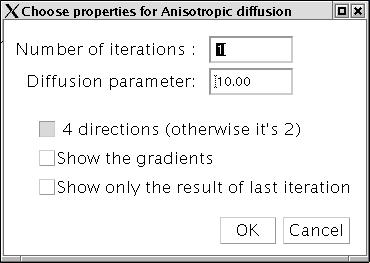Aim:
Improves the signal-to-noise ratio of images without degrading seriously edge contrast and resolution.
Method:
Anisotropic diffusion is now a well-established technique (see Perona & Malik, 1990), based on the resolution of partial differential equations which make the diffusion faster within objects or regions, and slower across edges.
This variant is a robust one, based on the paper:
Robust anisotropic diffusion. Black, Sapiro, Marimont & Heeger.
IEEE Trans. Image Proc. (1998) 7 (3), 421-432.
User interface:

Number of iterations: chosen by the user
Diffusion parameter: depends on the amount of noise in the image.
Directions: 4 ==> 8-connexity (default value) 2 ==> 4-connexity
Shows the gradients: unclicked: No (default value); clicked: yes
Show only the result of last iteration : unclicked (default value): yes; clicked: a stack of images is produced, one for each iteration (see the illustration below)
When the diffusion parameter is not set by the user, it is computed automatically, as described in the paper by Black et al.
Improves the signal-to-noise ratio of images without degrading seriously edge contrast and resolution.
Method:
Anisotropic diffusion is now a well-established technique (see Perona & Malik, 1990), based on the resolution of partial differential equations which make the diffusion faster within objects or regions, and slower across edges.
This variant is a robust one, based on the paper:
Robust anisotropic diffusion. Black, Sapiro, Marimont & Heeger.
IEEE Trans. Image Proc. (1998) 7 (3), 421-432.
User interface:

Number of iterations: chosen by the user
Diffusion parameter: depends on the amount of noise in the image.
Directions: 4 ==> 8-connexity (default value) 2 ==> 4-connexity
Shows the gradients: unclicked: No (default value); clicked: yes
Show only the result of last iteration : unclicked (default value): yes; clicked: a stack of images is produced, one for each iteration (see the illustration below)
When the diffusion parameter is not set by the user, it is computed automatically, as described in the paper by Black et al.